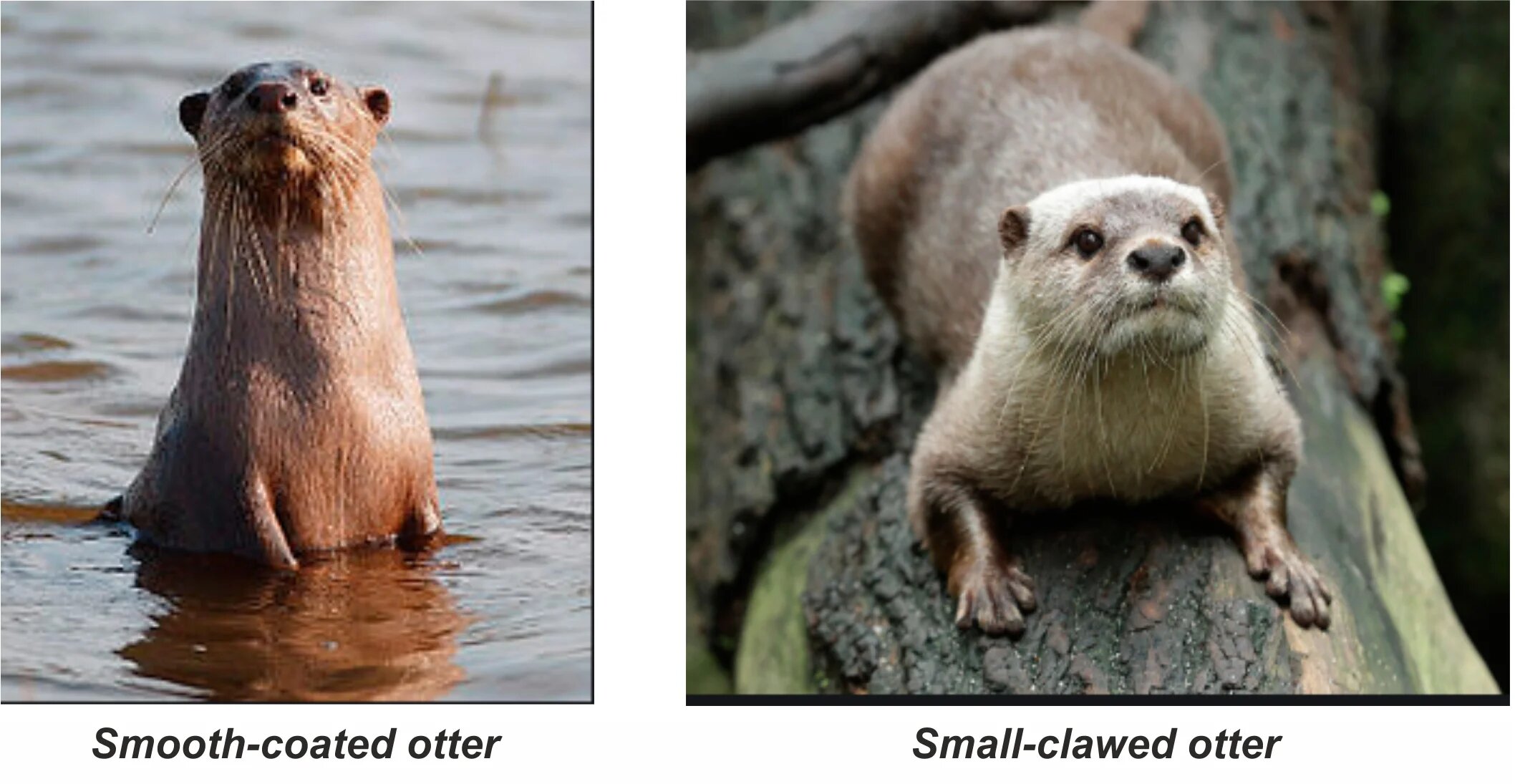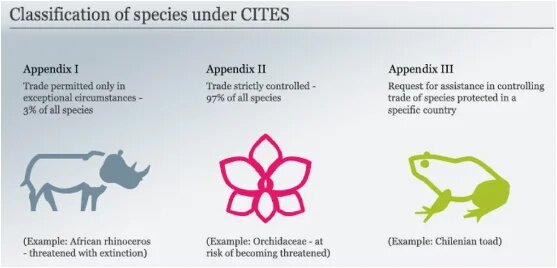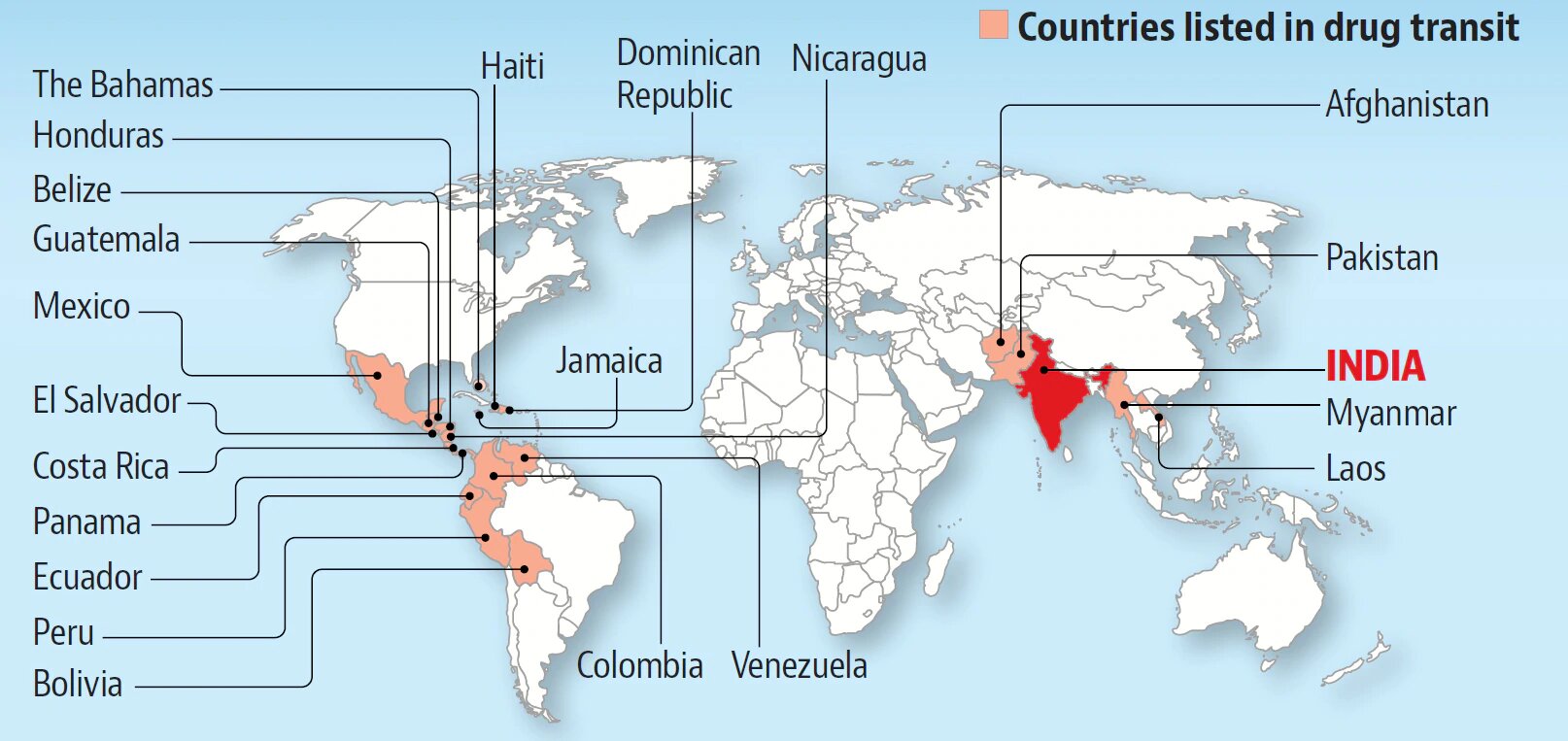Biodiversity & Environment
Proposals to Change in CITES Listing
India has submitted proposals regarding changes to the listing of the smooth-coated otter, small-clawed otter, Indian star tortoise, Tokay gecko, wedgefish and Indian rosewood in the CITES secretariat meeting, scheduled in August 2019 in Geneva (Switzerland).
Smooth-coated otter and Small-clawed otter
- Otters are found world over, except in Australia, New Zealand, Madagascar, and other oceanic islands.
- India is home to 3 of the 13 species of otters found worldwide. These are - Eurasian Otter (Lutra lutra); Smooth-coated Otter (Lutra perspicillata) and Small-clawed otter (Aonyx cinereus).
- The Smooth-coated Otter is distributed throughout the country from the Himalayas southward.
- But the Common Otter and the Small-clawed Otter are restricted to the Himalayas, to the north of the Ganges and to southern India.
- These otters have generally been described as fish specialist.
- Major threats to Asian otter population are loss of wetland habitats due to construction of large scale hydroelectric projects, conversion of wetlands for settlements and agriculture, reduction in prey biomass, poaching and contamination of waterways by pesticides.
- The International Union for Conservation of Nature (IUCN) has listed these otters under the vulnerable category.
- India, Nepal and the Philippines have proposed that the listing of these otters should be moved from CITES Appendix II to Appendix I.
Indian star tortoise
- Indian star tortoise is found across the Indian sub-continent, more specifically, in the Central and Southern parts of India, in West Pakistan and in Sri Lanka.
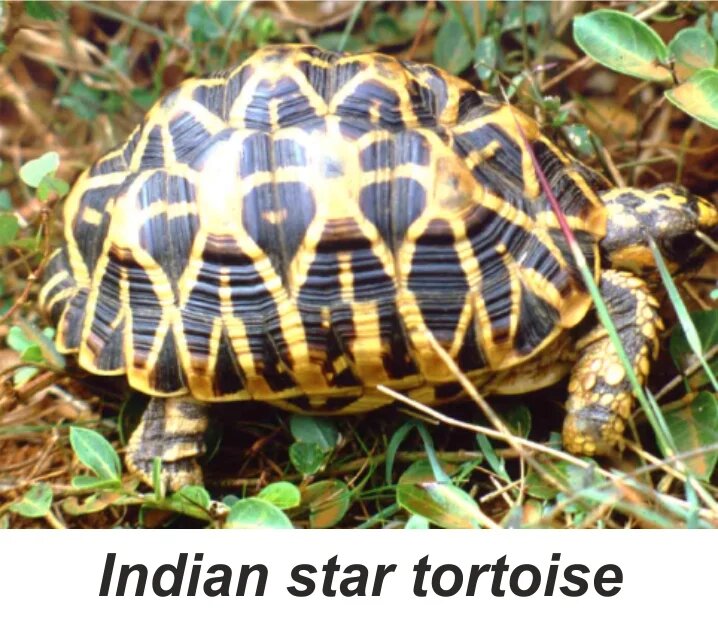
- Star Tortoises are protected under Schedule IV of Wild Life Protection Act, 1972 and Convention on International Trade in Endangered Species (CITES) of Wild Fauna and Flora.
- The IUCN has listed it under the vulnerable category.
- The species faces two threats: loss of habitat to agriculture and illegal harvesting for the pet trade.
- India is among the parties proposing the re-listing of the star tortoise from CITES Appendix II to Appendix I.
Tokay gecko
- The Tokay Gecko or Gekko gecko is one of the largest geckos (Lizard) in the country and the world.
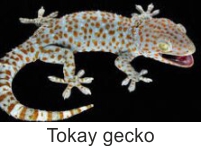
- This is a nocturnal arboreal gecko, ranging from northeast India, Nepal and Bangladesh, throughout Southeast Asia.
- Occurring in the rainforests, it is primarily a tree-dweller.
- It’s use as a traditional Asian medicine —everything from energy drinks to treatments for diabetes, cancer, and HIV/AIDS (there is no proof of efficacy in any of these uses), make it prone to illegal trade across borders.
- The IUCN has listed it under Least Concern category.
- India has proposed it’s listing should be moved from CITES Appendix II to Appendix I.
Wedgefish
- Wedgefish are shallow water coastal species, found in northern Indian Ocean and northwestern Pacific Ocean.
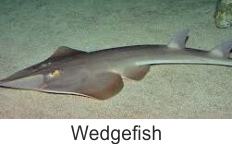
- Alongwith giant guitarfishes, they are collectively known as Rhino Rays because of their elongated snouts.
- They have been listed as the ‘most imperilled marine fish families in the world’.
- The main drivers of the decline are the loss of free flowing rivers and increasing agricultural and urban pollution.
- The IUCN has listed it under vulnerable category.
- Indian proposed to include Wedgefish in Appendix II of CITES.
Indian rosewood
- It is deciduous rosewood tree native to the Indian subcontinent, also grown in Nigeria, Kenya, Vietnam, the Philippines, and other parts of tropical Africa.
- It is used for making furniture, plywood, and decorative wood products.
- The species grows at a very fast rate and has the capacity to become naturalised outside its native range, it is invasive in other parts of the world as well.
- India has proposed to remove rosewood from Appendix II of CITES.
- Its IUCN Red List status is ‘vulnerable’.
CITES Appendices
- Appendices I, II and III to the Convention are lists of species afforded different levels or types of protection from over-exploitation.
- Appendix I
- It lists species that are the most endangered among CITES-listed animals and plants.
- Examples include gorillas, sea turtles, most lady slipper orchids, and giant pandas. Currently 931 species are listed.
- They are threatened with extinction and CITES prohibits international trade in specimens of these species except when the purpose of the import is not commercial, for instance for scientific research.
- Appendix II
- It lists species that are not necessarily now threatened with extinction but that may become so unless trade is closely controlled.
- International trade in specimens of Appendix-II species may be authorized by the granting of an export permit or re-export certificate.
- No import permit is necessary for these species under CITES (although a permit is needed in some countries that have taken stricter measures than CITES requires).
- Permits or certificates should only be granted if the relevant authorities are satisfied that certain conditions are met, above all that trade will not be detrimental to the survival of the species in the wild.
- Appendix III
- It is a list of species included at the request of a Party that already regulates trade in the species and that needs the cooperation of other countries to prevent unsustainable or illegal exploitation.
- Examples include map turtles, walruses and Cape stag beetles. Currently 147 species are listed.
- International trade in specimens of species listed in this Appendix is allowed only on presentation of the appropriate permits or certificates.
- Species may be added to or removed from Appendix I and II, or moved between them, only by the Conference of the Parties.
- However, species may be added to or removed from Appendix III at any time and by any Party unilaterally.
Science & Technology
Software Defined Networking
Software Defined Networking (SDN) is a network architecture approach that enables the network to be intelligently and centrally controlled, using software applications.
SDN enables network behavior to be controlled by the software that resides beyond the networking devices that provide physical connectivity.
What is the need of SDN?
- The monumental growth in multimedia content,the impact of increasing mobile usage, and increasing competition, pressuresizes the business to reduce costs.
- To keep pace, many global technology companies are turning to SDN technology to revolutionize network design and operations.
How SDN can bring a paradigm shift?
- By opening up traditionally closed network platforms and implementing a common SDN control layer, operators can manage the entire network and its devices consistently.This will allow optimum use of resources.
- By decoupling the hardware from the software, operators can introduce innovative, differentiated new services rapidly— free from the constraints of closed and proprietary platforms.
- SDN architectures usher in a new era of openness—enabling multi-vendor interoperability.
- SDN can manage the network efficiently, thereby improving the performance of Big Data applications.
- SDN can greatly facilitate big data acquisition, transmission, storage and processing.
- SDN too can benefit from big data, in terms of traffic engineering and countering security attacks.
What are the issues in SDN?
- Creating SDN architecture will be a difficult process for many small and mid range organizations. Thereby SDN will provide advantage to technology giants and thereby further augment global technological inequality.
- There is much clamour about data privacy. In this context, SDN too will get into the data protection debate.
Biodiversity & Environment
Mercury Emission Versus its Concentration in Fishes
Recently researchers have found that despite a decrease in seawater concentration of methylmercury, the amount of mercury found in fish is different among different species
- A joint research conducted by the Indian Institute of Technology, Hyderabad (IIT-H), Harvard University, and Fisheries and Oceans Canada (a Canadian government agency) has found that though there has been a decrease in the levels of mercury emission, the concentration of mercury in fish varies across different species.
- Some species of fish have less mercury than before, while others have a very high concentration of mercury (tuna, salmon and swordfish).
- The researchers warn that human exposure to the toxin (methylmercury) through fish consumption is bound to increase as a result of climate change.
Key Facts
- Mercury is a naturally occurring element that is found in air, water and soil.
- Exposure to mercury – even small amounts – may cause serious health problems, and is a threat to the development of the child in utero and early in life.
- Mercury may have toxic effects on the nervous, digestive and immune systems, and on lungs, kidneys, skin and eyes.
- Mercury is considered by World Health Organisation (WHO) as one of the top ten chemicals or groups of chemicals of major public health concern.
- People are mainly exposed to methylmercury, (an organic compound) when they eat fish and shellfish and are more vulnerable to Minamata disease.
- Minimata Disease: A disorder caused by methyl mercury poisoning that was first described in the inhabitants of Minamata Bay, Japan and resulted from their eating fish contaminated with mercury industrial waste.
- The disease is characterized by peripheral sensory loss, tremors, dysarthria, ataxia, and both hearing and visual loss.
- Methylmercury is very different to ethylmercury. Ethylmercury is used as a preservative in some vaccines and does not pose a health risk.
Variation in Mercury Accumulation in Fish: Three factors that can be attributed to the variation in accumulation of mercury in fish are: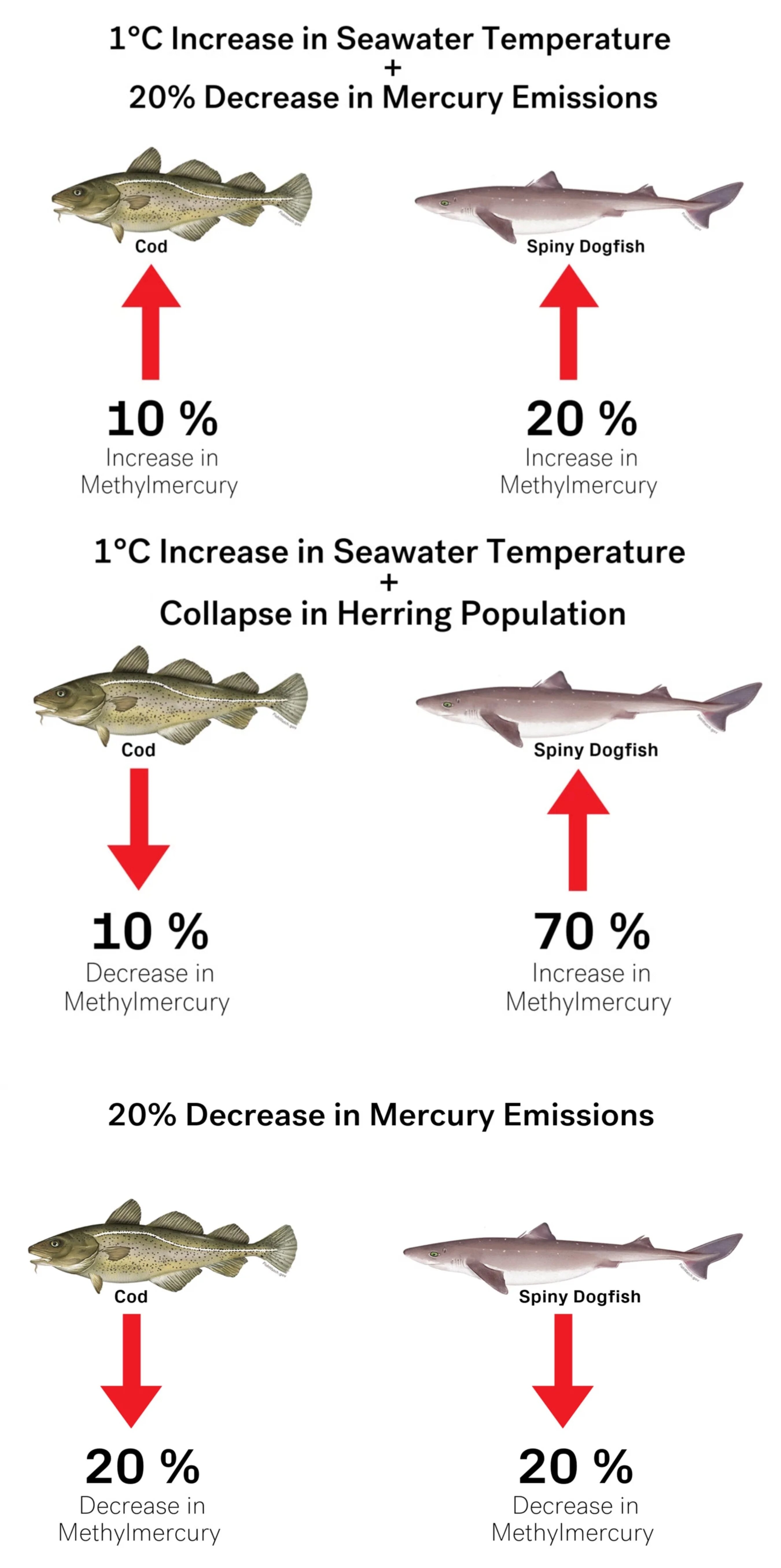
- Overfishing: Leads to dietary changes among marine animals.
- Cod relied more on lobsters and other large invertebrates (which are low in mercury), while the dogfish went for more squid and other cephalopods (which tend to be high in mercury).
- Hence cod ended up with lower mercury levels than the dogfish.
- Variations in the Temperature of the Seawater: Seawater temperatures may also alter mercury accumulation.
- Fish metabolism is temperature-dependent, so as ocean temperature increases, fish experience higher metabolism and more energy obtained from food are spent on maintenance rather than growth, leading to more methylmercury getting concentrated in predatory fish.
- Changes in the amounts of mercury found in seawater as a result of pollution.
The Minamata Convention
- The Minamata Convention on Mercury is a global treaty to protect human health and the environment from the adverse effects of mercury and its compounds.
- It was agreed at the fifth session of the Intergovernmental Negotiating Committee in Geneva, Switzerland 2013.
- Controlling the anthropogenic releases of mercury throughout its lifecycle is one of the key obligations under the Convention.
- The Convention also addresses interim storage of mercury and its disposal once it becomes waste, sites contaminated by mercury as well as health issues.
- More than 140 countries including India have ratified the Convention.
Indian Society
International Day of Indigenous Peoples
International day of indigenous people is observed on August 9 every year, in order to raise awareness of the needs of indigenous people. The first meeting of the UN Working Group on Indigenous Populations was held in Geneva in 1982.
- The theme of 2019 is Indigenous People’s Languages in view of 2019 being marked as the International Year of Indigenous Languages by the United Nations.
International Day of Indigenous Peoples in India
- On International day of indigenous people, the Khadi and Village Industry Commission (KVIC) has launched a new programme ‘Leather Mission’.
- It has distributed as many as 50 leather kits and 350 Bee-Boxes with live bee colonies in tribal-dominated village in Sirohi district of Rajasthan, one of the aspirational districts in India identified by the NITI Aayog.
Indigenous people
- They are inheritors and practitioners of unique cultures and ways of relating to people and the environment.
- They have retained social, cultural, economic and political characteristics that are distinct from those of the dominant societies in which they live. Despite their cultural differences, indigenous peoples from around the world share common problems related to the protection of their rights as distinct peoples.
- The indigenous people in the world make up less than 5 percent of the total population, but fall in the 15 percent of the poorest, according to the UN website. They represent as many as 5,000 different cultures.
International Year of Indigenous Languages
- Languages play a crucially important role in the daily lives of all people. They are pivotal in the areas of human rights protection, peace building and sustainable development, through ensuring cultural diversity and intercultural dialogue.
- However, despite their immense value, languages around the world continue to disappear at an alarming rate due to a variety of factors. Many of them are indigenous languages.
- Indigenous languages in particular are a significant factor in a wide range of other indigenous issues, notably education, scientific and technological development, the biosphere and the environment, freedom of expression, employment and social inclusion.
- The International Year of Indigenous Languages is a United Nations observance in 2019. It aims to raise awareness of the consequences of the endangerment of indigenous languages across the world, with an aim to establish a link between language, development, peace, and reconciliation.
Indian History
77th Anniversary of Quit India movement
The 77th anniversary of the August Kranti Din, which is considered as one of the important milestones in the history of freedom struggle of our country, was observed on August 8, 2019.
- On 8th August 1942, Mahatma Gandhi gave a clarion call to end the British rule and launched the Quit India Movement at the session of the All-India Congress Committee in Mumbai.
- The movement had begun from Gawalia Tank Maidan in Mumbai and the day is observed as August Kranti Day every year.
- After the failure of the Cripps Mission, Gandhiji gave the call “Do or Die”’ in his speech delivered at the Gowalia Tank Maidan, now popularly known as August Kranti Maidan.
- Gandhiji was soon imprisoned at Aga Khan Palace in Pune and almost all leaders were arrested.
- New leaders like Aruna Asaf Ali emerged out of the vacuum of leadership.
- The Britishers declared the INC to be an unlawful association.
- Over 100000 people were arrested and the government resorted to violence in order to crush the agitation.
- Gandhiji was released in 1944 on health grounds. However, in the absence of any central leadership, there were some incidences of violence.
- Muslim League, the Communist Party of India and the Hindu Mahasabha did not support the movement. The Indian bureaucracy also did not support the movement.
- The League was not in favour of the British leaving India without partitioning the country first.
- The Communist party supported the British since they were allied with the Soviet Union.
- Meanwhile, Subhas Chandra Bose, organised the Indian National Army and the Azad Hind government from outside the country.
- As, C Rajagopalachari was not in favour of complete independence he resigned from the INC.
- There were strikes and demonstrations all over the country and workers provided the support by not working in the factories.
- At some places (Ballia, Tamluk, Satara etc.) parallel governments were also set up.
- Women took active participation in the movement. Female leaders like Usha Mehta has helped set up an underground radio station which led to the awakening about the movement.
- Aruna Asaf Ali popularly known as the 'Grand Old Lady' of the Independence Movement is known for hoisting the Indian flag at the Gowalia Tank Maidan in Mumbai during the Quit India Movement.
- While the Quit India campaign was crushed in 1944, with the British refusing to grant immediate independence, saying it could happen only after the war had ended, they came to the important realization that India was ungovernable in the long run due to the cost of World War II.
Cripps Mission
- Japanese aggression in South-East Asia, keenness of British Government to secure the full participation of India in the war, mounting pressure from China and the United States, as well as from the Labour Party in Britain, led Britsh Prime Minister Winston Churchill to send Cripps Mission to India in March 1942.
- Under Stafford Cripps, the mission was sent to resolve the Indian question of a new constitution and self-government.
- Main proposals of the mission were:
- An Indian Union with a dominion status would be set up; it would be free to decide its relations with the Commonwealth and free to participate in the United Nations and other international bodies.
- A constituent assembly would be convened after the war to frame a new constitution.
- Members of the assembly partly elected by the provincial assemblies and partly nominated by the princes.
- Any province not willing to accept the constitution would be given ‘the same full status as the Indian Union’, - designed to appease the Muslim League’s call for Pakistan.
- The constitution making body and the British Government would negotiate a treaty to effect the transfer of power and to safeguard racial and religious minorities.
- The Indian National Congress, however, was not satisfied as its demand for immediate complete independence had been rejected.
- Mahatma Gandhi said that Cripps offer of Dominion Status after the war was a "post-dated cheque drawn on a failing bank’’.
Important Facts For Prelims
India in US list on Drug Transit
Recently, US designated India among about 20 major drug transit or illicit drug-producing countries.
- However, it also noted that a country’s presence on the list is not necessarily a reflection of its government’s counter-narcotic efforts.
- Apart from India, the countries identified in the list are Afghanistan, The Bahamas, Belize, Bolivia, Burma, Colombia, Costa Rica, Dominican Republic, Ecuador, El Salvador, Guatemala, Haiti, Honduras, Jamaica, Laos, Mexico, Nicaragua, Pakistan, Panama, Peru and Venezuela.
- There are a combination of geographic, commercial, and economic factors that allow drugs to transit or be produced, even if the government has engaged in robust and diligent narcotics control measures.
- For instance, India is in the middle of two major illicit opium production region in the world the Golden Crescent (Iran-Afghanistan-Pakistan) in the west and the Golden Triangle (South-East Asia) in the east.
Important Facts For Prelims
India’s First Ecotoxicology Clinic
Recently AIIMS, Delhi, launched a clinical ecotoxicology facility, a first-of-its-kind in India, to investigate increasing cases of diseases resulting from exposure to environmental toxins contaminating water, food and air.
- The new facility will provide diagnostic consultation as well as research services to all the clinical departments dealing with diseases due to ecotoxicity.
- What is Ecotoxicology?
- It is that branch of science that deals with the nature, effects, and interactions of substances that are harmful to the environment, on ecological entities, i.e. populations, communities or ecosystems.
- For example: Ecotoxicology will engage in knowing the origin of unknown factors of a certain rise in the number of cancer cases, even among those who don’t smoke.
- According to the Lancet Commission on Pollution and Health, contaminated water, air and soil are responsible for about nine million early deaths.
- About 92% of these deaths due to environmental toxicity occur in low-income and middle-income countries, which include India.
Source: TH
Important Facts For Prelims
World Biofuel Day
- The World Biofuel Day is observed every year on August 10 to create awareness about the importance of non-fossil fuels as an alternative to conventional fossil fuels.
- It is being observed by the Ministry of Petroleum & Natural Gas.
- The theme of the World Biofuel Day, 2019 is “Production of Biodiesel from Used Cooking Oil (UCO)”.
- The National Policy on Biofuels, released by the Government of India in 2018, envisages production of biofuel from UCO. Food Safety and Standards Authority of India (FSSAI) is implementing a strategy to divert UCO from the food value chain and curb current illegal usage.
- The benefits of transformation of UCO will help bring health benefits as there would be no recycling of the UCO, employment generation, infrastructural investment in rural areas & cleaner environment with reduced carbon footprint.
- To read more on biofuel click the link
Important Facts For Prelims
Virasat-e-Khalsa Museum
The Asia Book of Records has listed the Virasat-e-Khalsa museum in Punjab’s Anandpur Sahib as the most visited museum in the Asian sub-continent (on a single day).
- The museum had witnessed a record footfall of 20,569 visitors on a single day.
- The Limca Book of Records and India Book of Records had also listed ‘Virasat-e-Khalsa’ as the country’s top-ranked museum in terms of the number of visitors.
- The museum has been conferred an award by the Punjab Energy Development Agency in state-level energy conservation competition, for cutting down electricity consumption.
- The Virasat-e-Khalsa museum (the second most important Sikh shrine in Anandpur Sahib, after the Golden Temple complex) was built to commemorate 300 years of the founding of the 'Khalsa Panth' by the Guru Gobind Singh (10th Sikh guru).
- Museum also helped grow the economy of Anandpur Sahib in Punjab.
Important Facts For Prelims
Status of Financial Creditors to Home Buyers
The Supreme Court has confirmed the constitutional validity of the Insolvency and Bankruptcy Code (Second Amendment) Act of August 2018, which gave home buyers the status of “financial creditors” with power to vote in the Committee of Creditors.
- The Amendment Act allowed home buyers, as financial creditors, to trigger bankruptcy proceedings under the Insolvency and Bankruptcy Code (IBC) of 2016 and have their “rightful place” on the Committee of Creditors (CoC).
- The CoC, by voting, makes important decisions on the future of a bankrupt builder. These calls include what to do with his assets and who should finish the pending housing projects.
- As per the amendment, home buyers can initiate bankruptcy proceedings against errant real estate builders under section 7 of the IBC.
- Before the Amendment Act of 2018 came into existence, the assets of the bankrupt builder were divided among his employees, creditor banks and other operational creditors. Home buyers had hardly figured, despite they finance from 50% to even 100% of a housing project.
- Homebuyers now have the option to avail legal remedies before a consumer court, Real Estate Regulatory Authorities (RERA), as well as bankruptcy courts.

